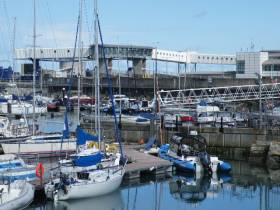Displaying items by tag: Stena HSS Berth Removal
Disused Stena HSS Berth to be Removed from Dun Laoghaire
#HSSberth – The disused Stena HSS berth at Dun Laoghaire Harbour is to be dismantled and removed in a process taking up to 10 weeks to complete, writes Jehan Ashmore.
Planning permission was granted to Stena by Dun Laoghaire-Rathdown County Council to dismantle berth No. 5 at St. Micheal’s Pier from where the final HSS Stena Explorer sailing to Holyhead took place in September 2014.
The operator having consolidated existing services on the Dublin Port route to the Welsh port that began in 1995.
Work at No. 5 berth is where the specialist docking infrastructure designed only for Stena HSS 1500 class fast-ferries, is to involve the removal of the linkspan, gangway and associated equipment.
A tug, MTS Valour is to begin towage of a barge from Stranraer, Scotland to Dun Laoghaire where the HSS related structures are to be loaded on board.
Coincidentally, Stranraer is also where Stena operated the HSS Stena Voyager in tandem with a pair of ferries on the Belfast route until switching Scottish ferryport to Cairnryan in 2011.
Also as part of the works in Dun Laoghaire (see Notice to Mariners No. 9) will be the removal of the pontoon at No 4 which is the adjacent berth on St. Micheals Pier. This berth-linkspan was last used by the smaller fast-ferry, Stena Lynx III until 2011.
Afloat.ie awaits a response from Dun Laoghaire Harbour Company to finally confirm proposals to restore seasonal-only ferry services to Holyhead, having begun a tendering process in February 2015.
Only in recent months saw the retail letting opportunity of the former ferry terminal and now the project to remove ferry-related infrastructure from the port.
Stena's Planning Application to Remove Dun Laoghaire HSS Berth Declared Invalid
#HSSberthRemoval - A planning application from Stena Line to remove its idle HSS fast-ferry berth in Dun Laoghaire Harbour, has been declared invalid due to failing to comply with articles in the planning procedures, writes Jehan Ashmore.
Dun Laoghaire-Rathdown County Council (DLRCoCo) has deemed the application submitted earlier this month to be invalid due to a failure to fully furnish documents in accordance with the Planning & Development Regulations 2001.
Among the articles not complied by Stena Line in its application to DLRCoCo, is the requirment that an applicant shall within the period of two weeks before the making of a planning application give notice of the intention to publish the application in a newspaper.
It transpires that the planning authority only received the application from Stena but this was submitted late, been one day beyond the required fortnight to be recognised valid.
Stena Line's head office in Holyhead (responsible that is for its Irish Sea south operations) has made no new resubmission to DLRCoCo to date.
The Stena HSS berth has remained redundant since the ferry operator withdrew the fast-ferry craft more than one-year ago in September 2014. The ferry firm decided to concentrate all operations in Dublin Port.
Prior to the transfer to the capital, Dublin Port has already been a customer of Stena since 1995, one year before the HSS Stena Explorer took up service on the Dun Laoghaire route. The former fast-ferry remains laid-up in the Welsh port, while two ferries operate the Dublin-Holyhead route which takes 3 hour 30 minute to complete the core central Irish Sea route.
As previously reported on Afloat.ie, Stena want to remove this year the specialist custom-built HSS craft berth linkspan, associated steel-supporting pier dolphins and concrete structures at St. Michael’s Pier. To give an indication, the outermost dolphin extends from the pierhead and is somewhat a little further into the harbour to that parrallel of the East Pier Bandstand.
The application would also involve work to dismantle where the 19,638 tonnes fast-ferry used to dock next to the connecting east/west walkway (double passenger enclosed gangways) structure and connecting walkways to the terminal completed in the mid-1990’s. There are plans to incorporate the proposed €18m cruise-berth’s associated passenger access and use of vehicle hard-standing areas within the disused ferry terminal.
Also last April, Afloat.ie contacted Stena which confirmed that as part of an agreement with Dun Laoghaire Harbour Company, they will have to remove the linkspan and that the ferry firm were seeking the assistance of Stena Metall and Stena Teknik.
In the request by Stena to remove the berthing equipment at St Michael’s Pier, this would mean that no other fast-ferry except for the high-speed sea service (HSS) can use this port infrastructure. Secondly, as referred above the HSS Stena Explorer is laid-up in Holyhead's inner harbour.
There are however several parties who responded earlier this year to DLHC with expressions of interest to resume the seasonal-only ferry service. According to the harbour authority, should there be a suitable operator this would be from the season of 2016.
Stena Line Looking to Remove HSS Berth at Dun Laoghaire Pier
#HSSberthRemoval – Ferry operator, Stena Line announced that is it to apply for planning permission to remove its idle ferry berthing equipment at St Michael’s Pier in Dun Laoghaire Harbour over the coming months.
Back in April, Afloat reported on the future of the specialist berth-linkspan built only for the Stena HSS fast-ferry (which closed services to Holyhead almost a year ago) against the backdrop of the proposed €18m cruise-berth.
The ferry company took an advertisement out in the Dun Laoghaire Gazette which reports of this story which said Stena Line would be submitting a planning application to Dun Laoghaire-Rathdown County Council but, as yet, Dun Laoghaire-Rathdown County Council has not received a planning application for the works.
As part of Stena Line’s planning notice, it has stated that it will remove the east/west walkway, terminal walkways and the supporting steel and concrete structure at St Michael’s Pier.
By removing the berthing equipment at St Michael’s Pier, high-speed sea service (HSS) ferries will no longer be able to berth in the locality, but currently the Stena Line HSS is the only HSS vessel that docks in the berth.
For more on this story and responses from local councillors, click here.






























































